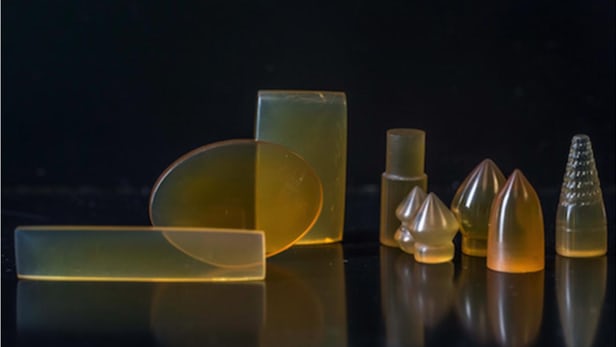
Scientists
say they've devised a way to create "programmable" silk-based forms
that have a variety of optical, chemical or biological functions. Imagine pins
or other mechanical components that change color when they near a breaking
point, or solids that can deliver drugs, among other possible uses.
Tufts University engineers used silk fibroin, the protein that makes silk durable, to create a three-dimensional bulk material using a water-based fabrication method. The material is what's known as a biopolymer, which are made up of bonded biological molecules that form larger structures. For example, cellulose is the most common biopolymer on earth. We've recently seen similar materials used to 3D print bikes, believe it or not.
The engineers developed a method to manipulate the bulk material with water-soluble molecules that can create new forms embedded with a variety of new functions. Rather than modifying an already-formed structure, the process allows the functional molecules to be integrated into the silk-based material as it forms. Similar methods have been used to create functional two-dimensional materials, but the Tufts team demonstrated the ability to build three-dimensional, programmable forms from the ground up.
The entirely water-based process used to create the forms starts with a solution that then transitions to a gel as the molecules bond and assemble the form. In its final stage the form is solidified, although one possible application of the technology includes loading a solid mechanical part with enzymes that could actually allow for growth over time, something that could be handy for biological implants.
A silk fibroin screw fabricated with golden nanorods can be heated to 160 C when exposed to infrared light emitted by an LED (Credit: Tufts University Silk Lab)
"The ability to embed functional elements in biopolymers, control their self-assembly, and modify their ultimate form creates significant opportunities for bio-inspired fabrication of high-performing multifunctional materials," said study author Fiorenzo G. Omenetto, Ph.D.
As part of their research, the engineers created a surgical pin that changes color to indicate when it is nearing its failure limit, functional screws embedded with gold nanorods that can be heated on demand in response to infrared light, and biologically compatible forms that can release drugs or other materials in the body over a period of time.
A silk fibroin pin changes color from blue to red when the force applied reaches the material's yield point(Credit: Tufts University Silk Lab)
The researchers say they can imagine other possible uses, like hardware that can sense and report the environmental conditions around it, or flexible household goods that can be reshaped as needed.
Basing the process on silk comes with the advantage of creating a material that is tough, durable, biocompatible and biodegradable. The versatile material also holds promise for boosting battery performance. More research is planned to try the material and process on new forms and functions.
The study was published in the journal Proceedings of the National Academy of Sciences.

 Previous page
Previous page Back to top
Back to top







